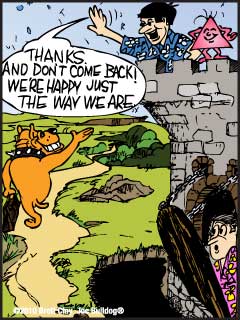Change Leadership — Secret # 99
Pour the Concrete
Nothing will work unless you do.
—Maya Angelou
What I Need to Know |
After the change is completed, the new situation starts to become the status quo. Roots start to sprout and people start to become entrenched, again.
But often there are forces pulling the change back to the former status quo. Some changes require constant reinforcement. Some changes feel like you are perpetually pushing that ore cart full of gold uphill. As soon as you think it is stable, it slowly starts to move backward. There are many reasons the change could tend back to the original state.
Even if the client is very happy with the change, he is still subject to the human tendency to feel some question or regret. This tendency, called “buyer’s remorse,” is when a person comes home with his shiny new widget he has wanted for so long and regrets that he purchased it. Many big consumer brands collectively spend billions of dollars on advertising, with the express purpose of—not convincing customers to buy the product—but rather, convincing them after they bought it that they did the right thing.
There’s a similar phenomenon called the “winner’s curse.” This is the dilemma that the buyer must have paid too high of a price, because the seller accepted it. There is also the dilemma that the seller must have accepted too low of a price because the buyer was willing to pay. The only way to be sure the price is not too high or too low is if the other side walks away from the bargaining table. So even the happiest client needs encouragement and affirmation.
What I Need to Do |
Another cause of buyer’s remorse and potential regression to the status quo could be resistors and critics. No change goes perfectly, and you can always count on the critics to say, “See! See! I told you it wouldn’t work!” This is the time to remind everyone of the benefits of the change and all of the progress that has been made.
In some cases, by the time the change has been completed, other changes have occurred that reduce the effectiveness and benefits of the change. In these cases, the client either must accept the change as it is or modify it. Either option the client chooses will require additional effort—reinforcement to keep the change from going backward.
At some point, after the change has been long since accepted and the reinforcements have locked it in place, people adapt and become comfortable, building castle walls around the new status quo. The change cycle then starts anew. As Maslow says, “Man is a perpetually wanting animal.” The satisfaction of one need creates a dissatisfaction with another. Prepare to satisfy the next “need.”
Action Summary |
|
 |



Social